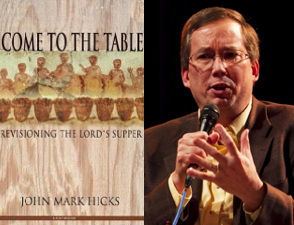 Using a better grasp of Torah and God’s divorce from Israel as a backdrop, I turned to the marriage and divorce texts in the synoptic gospels. The God of the Hebrew Bible was also the God of the New Testament. He had not changed nor had his will. However in many respects I began to realize my own deficiency in acknowledging God’s continuity in his attitude toward marriage. While at this point I was still years away from finalizing my thoughts, the seeds of a different view on marriage, divorce and remarriage were planted.
Using a better grasp of Torah and God’s divorce from Israel as a backdrop, I turned to the marriage and divorce texts in the synoptic gospels. The God of the Hebrew Bible was also the God of the New Testament. He had not changed nor had his will. However in many respects I began to realize my own deficiency in acknowledging God’s continuity in his attitude toward marriage. While at this point I was still years away from finalizing my thoughts, the seeds of a different view on marriage, divorce and remarriage were planted.
When not addressed in person, issues in the early church were addressed by pen—in the form of a letter or a gospel (Jas 1:1). While both were responses to situations, they were constructed differently. The more I learned, the more I realized that unlike biographies of today, the gospels were life stories that were written with theological objectives. I quickly grasped how significant this would be.
I began my study of marriage and divorce in the synoptic gospels (Matthew, Mark, and Luke) with Mark 10:1-12 because it is considered to be the first gospel written. Neither Matthew nor Luke had written their gospels at the time of Mark’s writing so he had no access to their texts, however Matthew could have used the gospel of Mark as a resource. With this in mind I compared the Mark text with a similar text in Matt 19:1-12 and studied the fourteen differences in the recording of the Jesus-Pharisee dialogue by the two authors. This prompted extensive research into the individual gospels and after a period of time I realized my previous approach to their study had been incorrect. I concluded that I had thought and had even taught that the synoptic gospels could be harmonized; however doing so distorted the unique objective each writer had for their readers (Matt 24:15; Mark 13:14). Each gospel writer achieved his objective by the selection, arrangement, and adaptation of the information about Jesus that he included. Efforts to understand each gospel text could not be limited by who wrote it, to whom and why, but should also take into account the selection, arrangement and adaptation of the material in order to grasp the theological objective. For example, Mark evidently adapted his text to fit his mostly non-Jewish audience and his purpose for writing by including Jesus’s reference to a woman divorcing her husband (under Jewish law that was impossible because she was the property of her husband). Matthew, who omitted the illustration, wrote to a Jewish audience who would have recognized a woman could not divorce her husband. When Matthew mentioned Jewish practices he did not explain them as Mark had done to his non-Jewish readers (Matt 15:1-6; Mark 7:1-13). The teaching on divorce in Matthew 19 is one of two examples showing the fallacy of law keeping (a non-issue to Mark’s mostly Gentile audience) as opposed to humble servanthood. As with 1 Corinthians 7, each of the synoptic gospels had an occasion for which they were written. However unlike 1 Corinthians 7, the gospels encompassed two occasions. The first was the occurrence of the actual event and the second how the author used the event to achieve his theological objective when penning his gospel years later. This understanding explained why the events were not recorded in the same way and why some of the writers did not use the same stories or materials.
With this perspective in mind I moved my focus to Matt 5:32 and tried to approach the text as the people would have heard and received it. Like Paul, Jesus was a Torah observant rabbi (Matt 5:17-20). Because the Deut 24:1-4 text is mentioned in three of the marriage and divorce passages in the synoptic gospels I felt the need to revisit that text. Admittedly, defining the word indecent was problematic, but even so the concession was granted because of hard-hearted men. The more I studied, the more I realized the text had a three-fold purpose: (1) to keep divorce from occurring, (2) to protect women, and (3) to protect a second marriage. Building on Jesus’ rabbinic background I returned to Matthew and soon realized, among other things, that Matthew 5:32 could not be understood literally without violating Deut 24:1-4—something Jesus would never do. He had come to clarify (fulfill) the law not to abolish it. Because of his respect for Torah and its intended meaning, throughout the sermon on the mount Jesus had chosen to use a very common teaching style at that time (hyperbole and metaphor) to make his point. With this understanding the teaching of Matt 5:32 became clear: Jesus was opposed to divorce. He was not answering the question can divorced people marry, but can married people divorce. The similarity of the teachings found in Matthew 5, 19 and Mark 10 all provided a uniform message: disciples do not divorce.
The Luke 16:18 text was more of a challenge to understand because of it’s vague context. Luke chose not to include the Pharisee-Jesus dialogue for his readers however the text did compare favorably with Matt 5:32. It is located in a cluster of teachings about money and greed so perhaps this text is best seen as an illustration of those who would divorce and marry to gain another dowry (Luke 16:14). Again the teaching is there: disciples do not divorce.
To be continued…
To read the article previous to this: A Fifteen-Year Journey, Pt. 1
To read the following article: A Fifteen-Year Journey, Pt. 3
 The influence of the Roman Catholic Church (RCC) on views of marriage, divorce and remarriage has been profound. As one of the seven sacraments, marriage and its guidelines are based on scripture. However since the church produced the scripture, the church has the authority to interpret its meaning.Specifically, the following scriptures provide the framework for the Indissoluability of marriage:
The influence of the Roman Catholic Church (RCC) on views of marriage, divorce and remarriage has been profound. As one of the seven sacraments, marriage and its guidelines are based on scripture. However since the church produced the scripture, the church has the authority to interpret its meaning.Specifically, the following scriptures provide the framework for the Indissoluability of marriage: The couple is united (glued) together and cannot be separated (Gen 2:24; Matt 19:6).
The couple is united (glued) together and cannot be separated (Gen 2:24; Matt 19:6). In the example of the observance of the Lord’s Supper in the gospels, we find the following: (a) people reclined around one table (Matt 26:20); (b) it was done in the upper room (Luke 21:12); (c) it was taken in context with a common meal , the Passover, (Matt 26:21, 26); (d) it was taken with thanksgiving (Matt. 26:26); (e) it was observed on a Thursday night (Matt 26:17); (f) it involved twelve people (Matt 26:20).
In the example of the observance of the Lord’s Supper in the gospels, we find the following: (a) people reclined around one table (Matt 26:20); (b) it was done in the upper room (Luke 21:12); (c) it was taken in context with a common meal , the Passover, (Matt 26:21, 26); (d) it was taken with thanksgiving (Matt. 26:26); (e) it was observed on a Thursday night (Matt 26:17); (f) it involved twelve people (Matt 26:20).